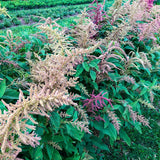Aleho (Amaranth)
Amaranthus spp.
Aleho is the Yoruba word for edible amaranth greens in Nigeria. Much like our Jamaican and Trinidadian Callaloo, this plant is grown for its abundance of iron-rich, spinach-like leaves, which are cooked into flavorful stews.
This variety comes to us from the Nigerian family of Halima Salazar, now of Justevia Teas in Water Valley, Mississippi.
This variety has a red tint to the leaves and grows up to four feet tall if left unharvested. However, you can harvest the greens continually, starting when the plant is as young as 18" tall.
We received this variety from Halima, who also shared these recipes from her mother:
Recipe 1
Ingredients
- 1 bunch of aleho
- 2 red bell peppers (red fresno peppers are great as well if you find some)
- 1 scotch bonnet pepper (remove seeds so it’s not spicy)
- half a large red onion
- two roma tomatoes
- salt
- cumin
- curry
- a bouillon cube unless you can find fermented locust beans or dawadawa
- at least 1/4 cup of palm oil or any oil (sometimes I’ll use more)
- fresh shrimp or fish filet of any kind (mainly catfish or tilapia), or if you have grilled pieces of chicken that’s also acceptable
Directions
- Blitz the peppers, tomatoes, scotch bonnets, and onions in a blender.
- Put oil in a pan and when it’s hot, pour mixture into it.
- Add spices including bouillon or dawadawa.
- After it has cooked for about 4 mins, add protein, cover, and let the flavors cook into the protein. Taste for salt.
- Add chopped aleho and mix it in.
- If you have fish in your recipe, take the fish out so it doesn’t break and lay it back on the greens after the meal is almost ready.
- Don’t cook the greens for too long. If it loses its color then it is believed to have lost its nutritional value. You want it not raw but still green and a bit crunchy.
Recipe 2
Another recipe we always had growing up and it brings back memories is when my mom made a sauce that would go with rice. Whenever she boiled the rice, about 5 mins before she turned it off she would add chopped aleho to the top corner and salt it then serve it with the sauce.
Days to maturity: 30
Seeds per pack: 200
Germination rate: 99% on 05/19/2025
Planting / harvesting notes
Leaf amaranth is an extremely self-sufficient crop. Expect germination between 10-20 days, and fast growth after that. To get a head start on the season, sow seeds 2-4 weeks before the last frost lightly covered in pots or trays in a greenhouse or sunny window. Transplant 1-2' apart into the garden a couple weeks after the last frost, when the soil has warmed a bit. At this point on our farm, amaranth has seeded itself enough that we harvest many young, tender plants whole at 12" as a way of thinning, but the plants we allow to mature are given about 2' space in each direction. Mature plants have deep pink taproots that allow them to go long periods of time without watering, and shoot up thick, bushy branches.
Seed keeping notes
Aleho is wind pollinated and can cross pollinate with many other varieties of Amaranth. Isolate by a minimum of 500 feet or cover the flowers with corn tassel bags to prevent unwanted cross pollination. Seeds are ready when they start dropping from the seed head, which matures after the flower dies back. You can cut the whole seed head and hang it to dry and mature further in a dry, ventilated place, or you can shake it while still on the plant every day or two, as the seeds ripen at different times starting from the bottom to the tip. Either way, shake the plant in a bucket to release the seeds. Use a strainer to sift out the larger chaff. Use your breath, wind, or fans to winnow off lighter weight chaff.









